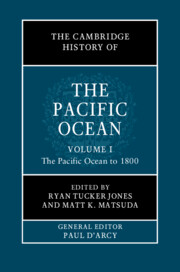Book contents
- The Cambridge History of the Pacific Ocean
- The Cambridge History of the Pacific Ocean
- The Cambridge History of the Pacific Ocean
- Copyright page
- Contents
- Figures
- Tables
- Contributors to Volume I
- Frontispiece
- General Editor’s Introduction
- Preface to Volume I
- Part I Rethinking the Pacific
- Part II Humans and the Natural World in the Pacific Ocean
- Part III Deep Time: Sources for the Ancient History of the Pacific
- Part IV The Initial Colonization of the Pacific
- Part V The Evolution of Pacific Communities
- Part VI Europe’s Maritime Expansion into the Pacific
- 28 Iberian Conceptions of the Pacific
- 29 Naval Rivalry in the Western Pacific: Portugal, England, Holland, and Koxinga, 1600–1720
- 30 The Resurgence of Chinese Mercantile Power in Maritime East Asia, 1500–1700
- 31 The Enduring Sea Cultures of Southeast Asia, Seventh–Seventeenth Centuries
- References to Volume I
- Index
29 - Naval Rivalry in the Western Pacific: Portugal, England, Holland, and Koxinga, 1600–1720
from Part VI - Europe’s Maritime Expansion into the Pacific
Published online by Cambridge University Press: 11 November 2022
- The Cambridge History of the Pacific Ocean
- The Cambridge History of the Pacific Ocean
- The Cambridge History of the Pacific Ocean
- Copyright page
- Contents
- Figures
- Tables
- Contributors to Volume I
- Frontispiece
- General Editor’s Introduction
- Preface to Volume I
- Part I Rethinking the Pacific
- Part II Humans and the Natural World in the Pacific Ocean
- Part III Deep Time: Sources for the Ancient History of the Pacific
- Part IV The Initial Colonization of the Pacific
- Part V The Evolution of Pacific Communities
- Part VI Europe’s Maritime Expansion into the Pacific
- 28 Iberian Conceptions of the Pacific
- 29 Naval Rivalry in the Western Pacific: Portugal, England, Holland, and Koxinga, 1600–1720
- 30 The Resurgence of Chinese Mercantile Power in Maritime East Asia, 1500–1700
- 31 The Enduring Sea Cultures of Southeast Asia, Seventh–Seventeenth Centuries
- References to Volume I
- Index
Summary
Portuguese explorer Ferdinand Magellan is credited with naming the ocean Mar Pacífico, the ‘peaceful sea’, during his circumnavigation of the globe. But the western ocean world was anything but pacific. Magellan himself was killed by tribal warriors in the Philippine islands in 1521, incidentally becoming one of the first European casualties in what would be a bloody sixteenth century in Asian waters. The Chinese would spend the middle of the century fighting tens of thousands of so-called ‘Japanese pirates’ and their ilk, who were in fact mostly Chinese, but who were also a polyglot confederation that included Japanese, Southeast Asians, multiracial freemen and slaves, and even a few Portuguese smugglers and pirates. Japan was split into a hundred fiefdoms and embroiled in a century of internecine competition and warfare, as were the diverse sultanates and states and city-states of mainland and island Southeast Asia. Meanwhile, the arrival of Jesuit priests, Japanese silver, gun-toting Portuguese interlopers, and Spanish New World silver and potatoes transformed this vast, complex trading world. Commercialism and maritime predation were thus well quickened in the western Pacific before the Dutch and English joined the fray at the dawn of the long seventeenth century.
- Type
- Chapter
- Information
- The Cambridge History of the Pacific Ocean , pp. 655 - 674Publisher: Cambridge University PressPrint publication year: 2023



